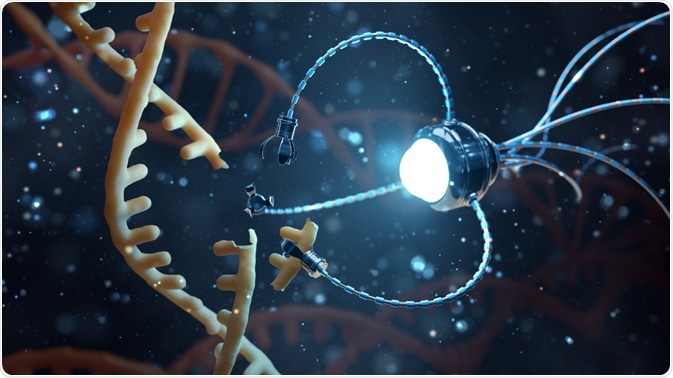Deoxyribonucleic acid (DNA) is the self-replicating genetic material that exists in nearly all living organisms. Aside from its role as a living material, synthetic DNA has also been investigated as a novel biomaterial for various purposes ranging from biological sensors and imaging tools to analytical applications.

Image Credit: K_E_N/Shutterstock.com
The basic working principle behind DNA nanotechnology is the fabrication of specifically shaped nano-architects in the one-, two, and three-dimensional (1D, 2D, and 3D, respectively) geometries through simple self-assembly of various DNA strands.
Types of DNA nanotechnology
In general, DNA nanotechnology can be categorized as structural and dynamic DNA nanotechnology; however, more recently, a new subfield of functional DNA nanotechnology has also emerged. Although these different types of DNA nanotechnologies share many similarities, certain distinct differences separate these materials from one another.
Structural DNA nanotechnology, for example, typically encompasses 2D and 3D static structures of varying sizes and complexities that have been produced by ‘bottom-up’ DNA self-assembly. The complex and multidimensional objects that make up structural DNA nanotechnology are often joined together through the addition of sticky tails to the scaffold strands.
Comparatively, dynamic DNA nanotechnology emerged to expand the capabilities of structural DNA nanotechnology to allow for the development of reconfigurable and autonomous devices. Moreover, dynamic DNA nanotechnology relies upon the combination of DNA self-assembly with DNA strand displacement reactions. Taken together, these DNA devices are capable of altering their state following interactions with various inputs such as ions, chemical analytes, and biomolecules.
Finally, functional DNA nanotechnology arose in the interest of providing these DNA nanostructures with detecting capabilities. To create these types of DNA devices, synthetic DNA nanostructures can be modified with various entities ranging from aptamers and DNAzyme to i-motif nanostructures and antisense DNA molecules.
Such a modification allows for functional DNA nanostructures to be equipped with molecular recognition capabilities that respond to a wide range of external stimuli include nucleic acids, proteins, metal ions, heat, light, and altered pH levels.
Linear DNA nanotechnology
In 1998, Nadrian C. Seeman pioneered modern synthetic linear DNA nanotechnology, which was developed to construct specifically designed nano-architects comprised of definite shapes and physical features. The most common feature of linear DNA molecules is the double-stranded/B-form of DNA (dsDNA), which has a diameter of 2 nanometers (nm) and is capable of precise complementary base-pairing at the nanoscale.
Since its initial discovery, scientists have found linear DNA nanotechnology to have potential applications in the fields of drug delivery, bio-imaging, bio-sensing, bio-analytics, biomedicines, nano-electronics, and nano-devices used for biomedical engineering purposes.
Circular DNA nanotechnology
Despite the excitement that surrounded the successful use of linear DNA strands for the construction of nanostructures, further work in this area found that these structures lack the rigidity and mechanical strength required for several different applications.
To overcome these limitations, the circular DNA scaffold was introduced and has been divided into several subtypes of DNA technology, which include semi-synthetic DNA origami, synthetic short circular DNA technology, short circular 1D, 2D, and 3D nanotechnologies, as well as a hybrid protein-DNA nanotechnology.
DNA origami
The first type of circular DNA nanotechnology is the semi-synthetic DNA origami, which involves the use of a large single-stranded circular DNA template strand that is greater than 7,000 nucleotides in length. Typically, the large circular DNA template strand is mixed with several different staple strands, which causes the template to fold into specified shapes following hybridization and self-assembly processes.
The design of DNA origami has allowed for the production of DNA nanomaterials with well-defined shapes, uniform sizes, accurate spatial addressability, and exceptional biocompatibility. Additionally, since the surface of DNA origami is fully addressable, various ligands, oligonucleotides, antibodies, hormones, or labels can be incorporated onto this type of nanostructure.
Short circular DNA nanotechnology
Comparatively, short circular DNA nanotechnology is created following a series of circularization steps that convert the short linear template strand into a circular scaffold strand, which typically has a final length range from 34 to 128 nucleotides.
If a researcher is interested in creating a 2D short circular DNA strand, various short staple strands are incorporated into the self-assembly of the new strand following circularization. This self-assembly creates 2D DNA tiles, which are equipped with sticky ends that allow for immediate connection to the adjacent DNA tiles for the construction of pre-determined lattices.
Hybrid protein-DNA nanotechnology
To enhance the capabilities of 1D, 2D, and 3D DNA nanostructures, researchers have found that the addition of different functional groups to the DNA scaffold strand can allow for the establishment of bio-conjugates between the genetic material and various proteins, lipids, and other compounds.
In addition to expanding the potential applications of DNA nanotechnology through this technology, covalent linkages between DNA and proteins can also improve the stability of nanolattices.
Applications
The various advances that have led to the establishment of the aforementioned novel DNA nanotechnologies have allowed DNA strands to be routinely synthesized in almost any sequence and length.
Furthermore, DNA nanotechnology allows for researchers to take advantage of the specific features of nucleic acids, such as programmability, tunable multifunctionality, as well as low preparation and purification costs.
These unique properties of DNA nanomaterials have led to their incorporation into a wide range of applications ranging from cellular probes, drug delivery vehicles, and molecular imaging agents to electrochemical sensors and bio-analytical devices.
References and Further Reading
- Chidchob, P., & Sleiman, H. F. (2018). Recent advances in DNA nanotechnology. Current Opinion in Chemical Biology 46; 63-70. doi:10.1016/j.cbpa.2018.04.012.
- Suo, T., Sohail, M., Xie, S., Li, B., et al. (2020). DNA Nanotechnology: A Recent Advancement in the Monitoring of Microcystin-LR. Journal of Hazardous Materials. doi:10.1016/j.jhazmat.2020.123418.
- Baig, M. M. F. A., Lai, W., Akhtar, M. F., et al. (2020). DNA nanotechnology as a tool to develop molecular tension probes for bio-sensing and bio-imaging applications: An up-to-date review. Nano-Structures & Nano-Objects 23. doi:10.1016/j.nanoso.2020.100523.
- Ebrahimi, A., Ravan, H., & Khajouei, S. (2019). DNA nanotechnology and bioassay development. Trends in Analytical Chemistry 114; 126-142. doi:10.1016/j.trac/2019.03.007.
Last Updated: Aug 21, 2020